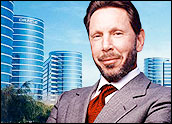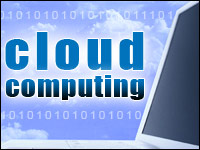
Cloud computing and Fusion Apps were the major points of Oracle CEO Larry Ellison’s keynote speech at Oracle OpenWorld 2010 on Wednesday.
Ellison also took several swipes at Salesforce.com and its CEO, Marc Benioff.
His speech concluded with an extensive demonstration of Fusion Apps, assisted by several Oracle executives.
Ellison also expressed support for recently appointed Oracle President Mark Hurd, who left his post as HP’s CEO because of questions over expenses claims and his relationship with an HP contractor.
Hurd continued his pop-in, pop-out performance, showing up briefly to introduce Infosys CEO Kris Gopalakrishnan, who kicked off the keynote session, before leaving the stage.
Oracle, the Cloud and Salesforce
“We mean by cloud computing what Amazon means by cloud computing — it’s a platform, hardware and software, it’s a computer,” Ellison told his audience. “A cloud is a lot of computers in a network — a lot of boxes and a lot of software. We think the box should be efficient, it should be fast, it should be reliable, and if you combine the hardware and software together in the box, you get a much better box.”
The box to which Ellison was referring is the ExaLogic Elastic Cloud, which he introduced at OpenWorld 2010 on Sunday.
“I have to chuckle a little at the phrase ‘cloud in a box,’ because the CEO of Salesforce.com said ‘Larry doesn’t get it, cloud doesn’t just run on a box,” Ellison said, in the first of many swipes at Salesforce and its CEO, Marc Benioff. “What does he think Salesforce.com runs on if not on a box? Salesforce.com runs on 1,500 Dell servers, which are boxes.”
Ellison also blasted Salesforce.com’s approach to cloud computing, which is based on multitenancy. Multitenancy is a principle in software architecture where a single instance of software runs on a server but serves multiple client organizations.
“Multitenancy is a horrible idea,” Ellison said. “What it means is, everyone’s data is commingled, everyone’s customer list is in a single database. That’s a horrible security model. In the 21st century, the way we support multiple customers is called ‘virtualization.'”
Ellison on Oracle Fusion Apps
Oracle’s 2004 purchase of PeopleSoft spurred the company to begin thinking about building Fusion Apps, Ellison said.
“When we completed the PeopleSoft acquisition and got JD Edwards as part of that acquisition, we suddenly had three different ERP systems and two different HRMS systems and knew we had to fuse them together,” Ellison remarked.
“Nobody until now has ever been successful in building large-scale ERP applications on top of industry-standard middleware, and we were determined to do whatever was necessary to make sure that we were going to deliver our next-generation applications that ran on industry-standard Java middleware technology,” Ellison pointed out. “We were absolutely committed to that in the design principle.
Another design principle is that Fusion Apps have to help users make better decisions.
“Information has got to provide a better payoff than automation on its own,” Ellison remarked.
The Unbearable Modernity of Fusion
The CEO also pumped Fusion Apps’ modern user interface.
“We all use Facebook, we all use Twitter,” Ellison explained. “We all know what modern applications look like. There’s all sorts of new user paradigms that have shown up in the past five, 10 years and we wanted to make sure that we exploited the latest user interfaces.”
Fusion Apps are built with “a bunch of Web services, and we use BPEL,” Ellison said. BPEL stands for Business Process Execution Language, and is a standard executable language for specifying actions within business processes with Web services.
Oracle’s aim was to make Fusion “very, very easy to integrate with your existing applications,” Ellison remarked. “Nobody’s going to rip out their existing applications and replace them.”
Further, Fusion apps had to be installable on premise or available in the software as a service (SaaS) mode.
“There’s one set of code. That’s never been done before,” Ellison pointed out. “Salesforce.com is just a SaaS application; you can’t install it behind your firewall.”
What’s a Standard?
Ellison’s claim about industry standard middleware should be taken with a grain of salt.
Oracle does build its middleware on top of industry-standard components like Java, Java Enterprise Edition and a number of Java frameworks and capabilities, Al Hilwa, a program director at IDC, told CRM Buyer. However, that’s not the whole story.
“One of the key issues is always what new innovations and modifications companies that use industry standard software add, and many do add proprietary enhancements, often because standards are inadequate in certain ways and it takes too long to fix them,” Hilwa pointed out. “Also, every vendor wants competitive differentiation.”
Oracle gives its users the choice not to use its proprietary enhancements, Hilwa noted. However, customers should exercise caution when making their decision.
“It is potentially possible to use other middleware in the middle of Fusion Apps but some features may not work, and likely Oracle may not be able to support the deployment,” Hilwa explained.
Loving That Hurd
Ellison also mentioned recently appointed Oracle President Mark Hurd in his keynote.
“We have a more experienced management team than ever before,” he said. “We’re very excited that Mark Hurd joined us from HP.”
Ellison also mentioned other executives who are now part of Oracle’s team.
Infosys Catches Up on Technology
Hurd introduced Infosys CEO and managing director Kris Gopalakrishnan, who told the audience that some of his company’s most exciting innovations are occurring at the intersection of digital consumers and pervasive computing.
One of Infosys’ focuses is the cloud; another is to let enterprises provide consumers information anywhere on any device, from their PCs to their TV sets to their mobile devices, also known as three-screen platform technology.
However, the three-screen idea has been bandied about for years.
“This was Bill Gates’ stump speech for years, and Steve Ballmer picked it up after he left so it’s hardly a new idea,” Rob Enderle, principal analyst at the Enderle Group, told CRM Buyer.
“It’s the direction the industry is going and the one consumers want it to go in, but three screens was so last decade,” Enderle pointed out. “This decade is simply about getting your data anyplace you are and the number of potential screens exploded beyond three some ago.”























































